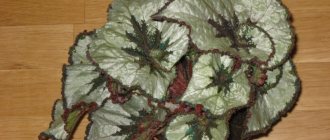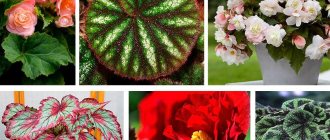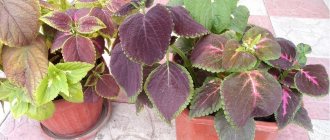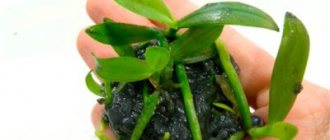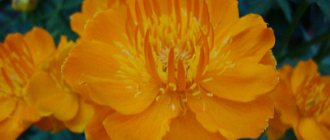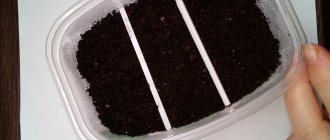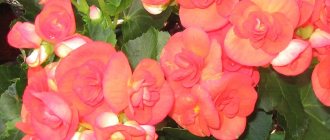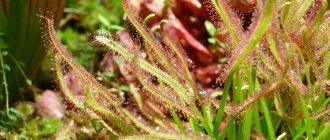Good afternoon, my dear readers. Today I again admired my beautiful begonia, but before I was quite skeptical about such plants. For understanding, let me clarify: we are talking about the Rex variety, which belongs to the group of decorative deciduous begonias, which have gained popularity precisely because of their magnificent greenery.
The flowers of such species are inconspicuous, but beautiful lush leaves successfully provide an alternative to them. Caring for them at home is not difficult, but the magnificent multi-colored greenery (and experts count up to 900 species) will bring you joy and positivity and will become a real decoration in the interior of your home.
Where does begonia grow best?
The homeland of this beautiful plant is the tropics and subtropics of Africa and South America, respectively, and when grown indoors they need to create similar conditions.
Begonia loves light, but does not tolerate direct, burning rays of the sun. Keep this in mind when planning the placement of flower pots, because one of the common mistakes of novice gardeners is placing plants in the sun. All three cardinal directions, excluding the fourth - the south, are suitable for begonias, so you can always find a place for the plant in the apartment.
IMPORTANT! Begonia, like many other flowers, does not like drafts, so care must be taken to ensure that these unpleasant phenomena are absent.
Home care
Each species has its own characteristics in maintenance and care at home. These plants are perennials, although they stop developing after 3 years. Adult bush species become excessively elongated and expose the stems from below, with decorative foliage they lose the brightness of their foliage, and flowering ones stop producing buds. But with proper care at home, indoor begonias can live for more than 10 years.
Reference! After the store, caring for indoor begonia at home is no different from usual, but it is worth paying a little more attention to the flower during the adaptation period.
Lighting and location
Most representatives of the genus are shade-tolerant, but love light. Plants with beautiful flowering prefer partial shade: direct sunlight can burn their leaves. Decorative deciduous varieties, on the contrary, need sunlight: they acquire a more variegated crown color. But they also need to be protected from harsh, aggressive rays.
Bauer's begonia or tiger (begonia bowerae)
Important! The duration of daylight for all species should be at least 12 hours.
The place where to place the container with begonia depends primarily on the species. What attracts more attention: flowers or the crown of a plant. You can place beautiful flowering ones on the windows of the east or west side, or next to it. It is better to place decorative deciduous trees on the window sills of southern windows and shade them at lunchtime.
Reference! Outdoor begonia does not overwinter in open ground, so landscape designers believe that begonia is annual.
Humidity
The flower loves high air humidity, about 60-70%. For home care, a humidity level above 50% will be sufficient. It is better to maintain high humidity using a humidifier or a tray with wet expanded clay. It is not advisable to spray the plant: drops of water can leave unsightly spots on the leaves.
Temperature
Begonia prefers moderate temperatures. In summer it should be kept within 18-23 °C. At higher temperatures, above 26 ᵒC, the plant loses its decorative appearance. The bush does not like sudden changes in temperature and drafts, and can react very sharply to them.
Important! In winter, you need to pay attention to the location of the flower: the crown should not touch cold windows. It is also important to monitor the temperature difference between the above-ground and underground parts of the plant.
In winter, the external temperature should drop below 13 ᵒC; it is better to place the plant in a room with a temperature of about 15 °C. At lower temperatures, the bush may get sick. The critical temperature is 4 ᵒC and below - if a flower is kept in a room with such a temperature, it cannot be saved.
Reference! Tuberous begonias have their own peculiarity: during the rest period, the above-ground part completely dies and is cut off, the remaining tubers are stored in a dark, cool place with a temperature of 7-8 ᵒC.
Rest period
Caring for indoor begonia at home in winter differs from summer. With the exception of tuberous plants, other species have a weak dormant period. Wintering of the flower occurs at 15-16 ᵒC. It is necessary to maintain high air humidity and long daylight hours using special lamps. You should not water begonia the same way as in summer - the soil may dry out faster or slower, so the watering regime should be adjusted. By spring, watering is gradually increased.
Reference! Ever-blooming varieties, if properly maintained and fertilized, require almost no rest period and bloom all year round. But it is also advisable for her to have a rest from January to the end of March, thanks to this she will bloom more abundantly and develop better.
Tuberous plants have a longer dormant period. Already in mid-October, she begins to prepare for rest on her own: the leaves begin to dry out and gradually die off. Gradually reduce watering and completely stop fertilizing the flower. If the plant does not go into a dormant state in the fall, then you need to forcefully prepare it: gradually reduce watering and cut off the stems at the soil surface. The pot with the tuber is covered with a bag or film and put in a dark place with a temperature of 7-9 ᵒC. The tuber is stored until spring, when it is transplanted into fresh soil.
Dormant period for begonia
Important! Until young tuberous begonias form a medium-sized tuber, they are not pruned and put into a dormant state like other species. Usually, after the first full flowering, the root system is fully formed.
Soil and pot
Begonias require nutritious soil with neutral or weak acidity (pH 5.5-6). The plant does not like stagnant moisture, so the soil should be loose and well-permeable to water and air. You can purchase a specialized substrate for begonias, or mix it yourself. The composition of the soil for begonias should include treated leaf soil, peat, humus and coarse sand in a ratio of 2:1:1:1. Instead of humus, you can use high-moor peat.
It is better to take a pot for begonias that is wide and not high: the roots will form correctly and the risk of hypothermia and rotting will be eliminated. When replanting, a new container is needed 3-4 cm larger than the previous one, with good drainage holes.
Important! If you transplant the bush into a pot with a large amount of free soil, then the roots of decorative deciduous begonias may turn sour, and flowering ones will not produce buds until the entire volume of the pot has been used.
For drainage, it is better to use expanded clay or large pebbles. It is poured into a third of the pot.
Transfer
Begonia needs to change the pot when the roots have completely mastered the lump of earth. Young plants up to 3 years old need it every year, and adults – once every 2 years. If the pot is not fully developed, then simply replacing the top layer of soil is enough.
Important! You cannot replant begonias during flowering after purchase. It is better to wait until the buds wither and then replant - if the flowers are left in it, they will wither.
Begonia root system
The procedure is carried out in the spring, at the beginning of the period of active growth. If the plant is healthy and there are no signs of disease, the flower is simply transferred into a new container. Before replanting, water the soil well: this will make it easier to remove the plant from the pot and maintain the shape of the soil. You can replant a store-bought begonia like a regular house one.
Attention! Due to the specific nature of the dormant period, tuberous varieties, with rare exceptions, do not require replanting. They are regrown every spring from tubers.
Pruning and rejuvenation
Crown formation is one of the most important stages of begonia care. If this is not done, the plant will eventually lose its decorative appearance: the stems will stretch out and become bare, the bushes will stop blooming. Formation depends on the type:
- In bush begonias, the height of the plant is controlled, the crown is formed in accordance with the wishes of the grower;
- Rhizome plants usually simply require rejuvenation: after 3 years, their stem becomes excessively elongated and bare;
- Tuberous and ever-flowering plants are constantly pinched, forming a crown;
- In ampelous begonias, at the beginning of the period of active growth, shoots are cut to a third of their length.
Sanitary pruning is carried out constantly: all leaves and stems that begin to dry out, and fading flowers are removed. How to prune begonia at home is located below (photo step by step).
Reference! For decorative deciduous flowers, they do not play a big role in appearance, so it is customary to remove them at the moment of inflorescence formation: when they bloom, they waste nutrients.
Watering
The plant tolerates drought more easily than excess watering, but you should not allow the soil to dry out too much either. Water begonia at home like ordinary indoor flowers: when the top layer of soil dries 1-2 cm. Use filtered or settled water. Tuberous species, due to the peculiarity of the root system, need to be allowed to dry out more of the earth - at least half. If the soil is too dry, you can place the pot in water for a few minutes: the soil itself will absorb as much as it needs, and the excess will drain off.
Attention! After buying a flower in a store, you should let the soil dry out more, this will help avoid overwatering.
Top dressing
The bush needs nutrients for growth and development, so the plant must be constantly fertilized. You can use either a special fertilizer for begonias or a complex mineral fertilizer. Feeding is required once every two weeks after watering. During rest, the plant is not fertilized.
Important! Large-flowered varieties begin to be fed after the buds form.
Room temperature
It is necessary to ensure a stable air temperature so that there are no sudden changes. You should also monitor the level of humidity, after all, this “miracle” comes from the tropics, and therefore dry air has a detrimental effect on the growth, condition and color of the leaves.
In this case, it is necessary to comply with the norm and avoid overmoistening, otherwise the begonia branches will begin to rot. The best option for winter, when operating heating systems “dry” the air, is to place flower pots in a tray with slightly moistened sphagnum or gravel.
Spraying is useful, but it must be done carefully and correctly so that drops of water do not fall on the leaves, but form a cloud around the plant. Only heated, settled or filtered water is used.
Your room will have a constant temperature and normal humidity, the begonia leaves will be rich in color, bright, and beautiful.
Varieties of decorative foliage plants
In addition to royal begonia, you can also find the following plant varieties:
- metallic begonia grows up to 1.5 meters. It has reddish stems with strong pubescence. The foliage is ovoid, greenish-olive in tone with reddish veins. Thanks to this color, it seems as if the leaves are covered with a metallic sheen. On the reverse side, each leaf is painted purple;
- Mason's begonia grows only 50 centimeters. It has recumbent, small, fleshy and thickened, heavily pubescent stems. The foliage is heart shaped. The green leaves have bright brown patterns;
- begonia Diadema has large leaves that are located on long petioles. The shape of the leaves resembles a diadem. The foliage is dark green with harmonious white patterns. The bottom of each leaf is purple;
- the Cleopatra variety is medium in size. The bush has kidney-shaped leaves with cut edges. The foliage has a green tint, a burgundy pattern is formed on the veins, due to which the begonia has a strict, impressive appearance;
- Begonia Tiger has many leaves, which are located on thin long petioles. They have an asymmetrical, heart-shaped shape, pointed at the tips. The foliage is bright green with large brown spots. The plant has slightly pubescent petioles and leaves;
- Imperial begonia grows to only 40 centimeters. It has kidney-shaped leaves with pointed edges. The plant is dark green in color with a creamy metallic pattern. It has low, large, slightly pubescent petioles;
- The branches of the white-painted begonia can grow up to 60 centimeters. The leaves are heart-shaped, slightly pointed. They are found on short petioles. The foliage is dark green with multiple small, white spots.
Let's talk about watering
From spraying, let's move on to the related topic of watering plants. In order for begonia to delight you with lush foliage, it is best to water it through a tray. In this case, you can avoid getting water on the surface of the beautiful carved leaves and over-moistening the earthen ball in the pot.
In winter, water moderately, in spring and summer - abundantly, avoiding stagnation of water.
Reproduction
Many domestic begonia species reproduce very easily. The most popular way to do this is cuttings. There is a universal answer to the question of how best to root leaf begonia. You need a cutting no more than 5 centimeters in length, place it in a glass of water at room temperature. Carry out this process in the spring. Instead of cutting the stem, cut off the leaves using a sharp knife. Be sure to disinfect all applied cuts with charcoal.
You can use the propagation method through a leaf plate, cutting it so that each piece leaves an intact central core. Afterwards, all parts of the sheet are laid out on loose soil, pressed into the soil, and the top must be covered with polyethylene or a lid. After the cuttings have taken root, transplant them into plastic cups. Under no circumstances should you immediately plant them in a large container, since the soil in such a pot cannot dry out quickly, and the plant can rot almost instantly.
Transfer
The basic rule is that the container where begonia grows should not be too spacious for it. This species grows better in small pots, but when replanting you need to take a pot a little larger (about a centimeter or two) than the previous one. Soil for decorative leaf begonia is a nutrient substrate, the main components of which are:
- peat;
- humus;
- deciduous soil;
- sand.
When the begonia “moves” to a new place, the earthen lump must be kept intact. This is especially important for decorative deciduous species, otherwise the greenery of the plant will lose its lushness and elasticity.
Planting and growing
It is advisable to plant decorative deciduous begonias in early spring. Begonia is a plant that is stressed by any planting or transplanting. Because of this, the development of the bush slows down. Carry out the planting process slowly and not in a heavily lit room. You need to be especially careful in a situation where you bring begonia from the store to the office. Before you purchased the begonia, it was grown in greenhouse conditions, but now it needs to get used to new, completely different conditions.
How to propagate begonia?
Do you really want to increase the number of these beautiful plants in your home? Then you need to know everything about the methods of propagating begonias in order to choose the most suitable ones for yourself.
IMPORTANT! Decorative deciduous begonia must be constantly renewed and this is best done with the help of cuttings.
Reproduction methods:
- seeds (material for planting is purchased at flower shops);
- leaves;
- stem cuttings.
One leaf, two leaves
The leaf propagation method is one of the most popular and simplest, and I grew my own begonia from just such a leaf.
To do this, you need to select a leaf on the plant, carefully cut it, let the cut dry slightly, and then plant the leaf in a prepared container with substrate. Some gardeners first put the leaf in water, wait for small roots, and then plant it in the ground.
Reproduction by stem
Propagation of begonia by stem cuttings gives good results; for this you need to select either young shoots or already slightly lignified parts. Prerequisite: presence of kidneys.
Leaves are removed from the cuttings, an oblique cut is made and placed in prepared pots with substrate. It is advisable to cover the top of the cuttings with film, but be sure to remove it for ventilation and watering. It is the film that will create the necessary greenhouse microclimate for begonias, and they will quickly take root. But as soon as the plants get stronger, the film must be removed so that the begonias can adapt to the room temperature.
IMPORTANT! Decorative deciduous begonia needs regular renewal, in which case you will always have beautiful plants with spectacular greenery.
Short description
Decorative deciduous begonia can have both regular and rounded leaves. Sometimes the foliage curls into a spiral. Also, some leaves may be cut off at the edges. The size of the foliage depends on the plant variety, so it can be dwarf or giant.
The leaves of the plant are green, dark red, yellowish, chocolate, brown or silver. Decorative deciduous plants have flowers that are too small, which are difficult to notice among the luxurious leaves.
The most commonly grown plant at home is royal begonia, whose leaves are colored in several colors at the same time. Their length can be 30 centimeters and width – 25 centimeters. A plant of this variety grows in the form of a bush that does not require special care.
You need to know the enemy
The list of “opponents” of begonia should include:
- dry air (we described in detail how to water and spray);
- powdery mildew;
- mold;
- gray rot;
- aphid;
- poutine mite.
To be fair, let’s say that these plants are quite unpretentious, they are resistant to diseases and pests, but if some kind of misfortune occurs, then improper care and non-compliance with the regime are most often to blame.
Mold and powdery mildew are removed with special compounds, after removing all plaque from the leaves. But in the fight against pests, infusions of ordinary garlic, chamomile or tobacco help well.
I think you are convinced that not much effort is required when growing begonias, but this flower will thank you with its magnificent colorful greenery.
Buy begonia in our online store
This indoor flower propagates both by cuttings and leaves or by dividing the bush. In addition, collectors often offer begonia seedlings, which can be purchased quite inexpensively.
If you want your home to be decorated with indoor begonia, our catalog, which presents a wide variety of varieties of this plant, will help you choose the most suitable varieties.
Please note that we send begonias by mail throughout Russia, and payment can be made either by bank card, electronic money or cash on delivery. You will receive a high-quality begonia cutting very quickly and inexpensively
By ordering such a plant from us, you will fall in love with the modest charm of begonia, the price of which is very attractive.
Diseases and pests
The greatest danger to beautifully flowering begonias is powdery mildew. Most often, it is recommended to immediately destroy the infected plant, since control even with the use of fungicides rarely brings positive results, and begonia almost always dies or loses its decorative effect so significantly that it is more expedient to save it by propagating it from cuttings. Gray rot (when the soil is waterlogged) and aphids are also found on flowering begonias, which are best dealt with immediately with insecticides.
Common growing problems:
- the appearance of spots on the leaves when drops of water get in contact with them;
- dropping buds in drafts or during sudden temperature changes;
- dropping leaves in the cold;
- blanching of leaves and elongation of shoots with strong shading;
- Drying of leaf edges and browning of leaves in direct sun or extremely dry air.
Begonia cucullata
Choosing a vessel for rooting
The plant has small roots, so you should choose a low pot with little volume. Thus, the substrate will quickly get rid of excess moisture, which will reduce the likelihood of its death. However, during rooting, the plant will not stay in the pot for long; when roots appear, it will be necessary to select an individual pot.
Note: The light required for cuttings is the same as for adult plants, so the rooting period should be carried out in a well-lit place. You can use a regular plastic cup as a pot.
The volume of the pot used after replanting should not exceed 800 ml, and a hole must be made in the bottom so that excess water can escape. If the plant grows too small in the pot, you will have to choose a larger option. After repotting, it is best to keep the plant in a darker place than usual for a few days.
Silver Star
A herbaceous plant reaching a height of 25-30 cm. The shrub has large, spectacular oval-shaped leaves with a pointed apex. The surface is lumpy due to small papillae located on it. The color is rich olive with light green veins, along which there are silvery areas that occupy most of the surface.
Pruning, rejuvenation and supports for begonias
Beautifully flowering begonias are usually pruned immediately after flowering. It is worth clarifying the information about the need for pruning and its features when purchasing. In ever-flowering begonia, elongated shoots are usually simply shortened and damaged and weak ones are removed. Otherwise, pruning comes down to removing flower stalks.
Due to their long and lush flowering, beautifully flowering begonias lose both their abundance of color and compactness with age. If the bushes lose their decorative properties, it is recommended to renew them using the cutting method. Drastic pruning as a method of rejuvenation is not suitable for beautifully flowering begonias. The standard frequency of rejuvenation is once every 2-3 years.
Beautifully flowering begonias are not only compact, but also very massive, and hanging plants are even capable of growing to enormous sizes. Because of their fragility, shoots are not always able to withstand the weight of huge inflorescences, and the most lush and massive profusely flowering begonias may need support in the form of a ladder or a circular “loop” to prevent breaking of succulent shoots.
The simplest classification of begonias
Begonia is a large genus of annual and perennial plants, including shrubs, herbs, subshrubs, and vines. In total there are about 1000 species, the number of which continues to grow.
If desired, you can choose begonia to suit every taste - the culture is amazing in its diversity. But species and varieties have something that unites them:
- unisexual flowers;
- asymmetrical leaves, called “elephant ears” - the central vein divides them into 2 unequal parts.
Flower lovers have dozens of classifications of begonias based on shape, color, size of flowers or leaves.
There are four large groups used for decorative purposes:
- deciduous;
- tuberous;
- beautifully flowering;
- shrubby.
By and large, begonias can have beautiful large leaves and inconspicuous buds, or decorative flowers and unremarkable small plates. There are no two species that combine both equally, but some shrub varieties are approaching them.
Just as begonias are varied, their care also differs significantly. Before purchasing, you should make inquiries about the species - perhaps it is so capricious that it simply cannot survive under normal indoor conditions.
Decorative foliage begonias
An extensive group with graceful leaf blades of bizarre shapes and varied colors. There are species intended only for greenhouses with high humidity or florariums. Some grow on ordinary window sills.
Imperial
Begonia imperialis is a rather capricious begonia. It forms rhizomes - rhizomes, which are modified creeping stems. Loves light and warmth, requires high humidity, but does not tolerate spraying of the aboveground part.
Very beautiful. The plant is up to 40 cm high and forms a lush bush with good care. The leaves are asymmetrical, 10 cm in diameter, with a heart-shaped base and a sharp tip. The upper part of the plate is velvety, silver, decorated with radial green stripes directed towards the edge, the lower part is red.
Royal or Rex
Begonia rex is a rhizomatous begonia, the care of which is considered one of the most difficult among indoor plants. Designed for growing in forariums. There are many varieties and hybrids - all incredibly beautiful, but very capricious.
The stem is lodging, thick, and under ideal conditions (which are very difficult to provide), an old species plant can reach a maximum size of 1.5 m. The flowers are small and have no decorative value.
The leaves are asymmetrical, covered with sparse long hairs, in representatives of the group they can reach a diameter of 5 to 20 cm, shape: round, elongated, dissected to varying degrees, twisted along the central vein like a snail. The plates are decorated with a variety of amazing patterns.
Usually a combination of several colors ranging from green so dark it appears black to silver, the surface appears velvety, but is actually covered with short, tightly packed bristles.
Bauer
Begonia bowerae is not the most capricious species and has produced several excellent varieties. It is a small bush up to 25 cm high with a creeping stem and heart-shaped, elongated leaves up to 10 cm long and 4-6 cm wide.
Depending on the variety, the plates may be smooth or covered with hairs. The upper side is green with black spots along the edges and along the veins, the lower side is light, with reddish veining.
Sizemore
Begonia sizemoreae is one of the hardiest decorative deciduous begonias. Grows up to 40-60 cm. The flowers are cute, pink, small, collected in panicles.
The leaves are in the shape of an asymmetrical oval with a rounded or pointed tip, the surface is wrinkled, the old plates are covered with long sparse white hairs, the venation is deep. The upper part is dark green with a silver circular stripe, the lower part is crimson.
Red leaf or fista
Begonia erythrophylla is shade-tolerant, relatively unpretentious, suitable for northern window sills. The stem is creeping, thick, the flowers are inconspicuous. The leaves are almost round, green with a bronze tan on top, red below.
Hogweed
Begonia heracleifolia is a variable species that has produced many cultivars. A great rarity among decorative deciduous begonias, even novice gardeners can take care of them.
The stem is long. If it is not pruned, it can be grown as a hanging plant. The leaves are relatively symmetrical, up to 25 cm in diameter, highly dissected, similar to maple. Petioles up to 40 cm. The species plant has a green color.
Varieties can be two-colored, bronze, with a reddish or purple tint, different in the depth of cut of the plates.
Masson
Begonia masoniana is a very beautiful rhizomatous spreading begonia 45 cm high. Round wrinkled leaves with a diameter of 15 cm are covered with velvety fluff. The plates are light green, along the large veins there are located reminiscent of a Maltese cross, so dark that wide stripes appear black.
Beautiful flowering begonias
The main advantage of these begonias is the flowers that completely cover the bush, because of which no one simply pays attention to the small leaves. With good care it can last all year round, but it is still recommended to give the plants a rest.
Unless begonia is grown at home as a kind of bouquet - it has bloomed and gone to the trash bin. Of course, no one does this with hybrid varieties.
Always blooming
Begonia semperflorens - home begonia, garden begonia, for growing in hanging containers outdoors. It is a perennial plant, but it is often used for only one season, especially when planted in a flower bed. Unpretentious, unpretentious, suitable for beginner gardeners. It has many varieties and participated in the creation of hybrids.
The bushes are small, from 8 to 30-40 cm in height. The plant is completely covered with flowers up to 5 cm in diameter in all shades of red or pink, or white. The leaves are small, round, usually green, red and bronze, rarely white or brown. There are varieties with spotted plates.
Tuberous begonias
Begonia tuberhybrida is used as a potted and garden plant. It is represented by many hybrids with a height of 20 to 80 cm with erect or hanging shoots.
Flowers are from 1.5 to 20 cm in diameter, double, simple, semi-double. Color – any, except shades of purple, blue or cyan.
Tuberous begonia is a hybrid. Botanists themselves do not know how many natural species participated in its creation, but claim that from 6 to 9.
Lorrain
Begonia x Lorrain - a group of hybrids up to half a meter high. They form a bush with thin, slightly downward-curving shoots. The leaves are round, green, with a sinuous edge, no more than 10 cm in diameter. The flowers are small, simple, pink or white, collected in panicles. The buds open in autumn or in the first half of winter.
Elatior
Begonia x Elatior is another hybrid group. Flowers can be simple or double, up to 5 cm in diameter, collected in loose panicles. Any color except shades of blue. The buds open regardless of the season. The leaves are round, with a serrated edge.
Shrub (shrub) begonias
An interesting group, although not as impressive as the previous two. Care is of medium difficulty, can be grown on a not too sunny windowsill.
Shrub begonias grown in pots include dozens of species. Each one is interesting in its own way. This sample is intended simply to provide an overview of the group.
Fuchsia
Begonia fuchsioides is perhaps the most famous species of bush begonia among gardeners who are not cultural fanatics. Forms an ascending bush up to 90 cm high. The leaves are small, up to 2 cm long, oval, tapering at the ends, jagged along the edge, green, shiny.
Flowering is long-lasting, with good care - from late winter to autumn. The buds are bright pink, 1.8-2.5 cm in diameter, collected in tassels of 7-11 pieces. Sometimes the species is classified as a beautiful flowering plant - the plant really resembles fuchsia.
Reed (Kane)
Cane-like begonias are a group of varieties with stiff, erect stems that have thickenings at the nodes, like bamboo. The height of some varieties can reach 4.5 m, and the length of the leaves is 35 cm. The plates are asymmetrical and pointed.
Some varieties are grown only for their leaves and the original shape of the plant. Others attract attention with pretty fragrant flowers.
Spotted
Begonia maculata includes Begonia coral, previously considered a separate species. This is a beautiful herbaceous shrub, growing up to 45-60 cm with a crown diameter of 1 m. The leaves are smooth, with a sinuous edge, up to 15 cm long, no more than 5 cm wide. The upper part of the plate is dark green, covered with silver specks, the lower part is reddish.
